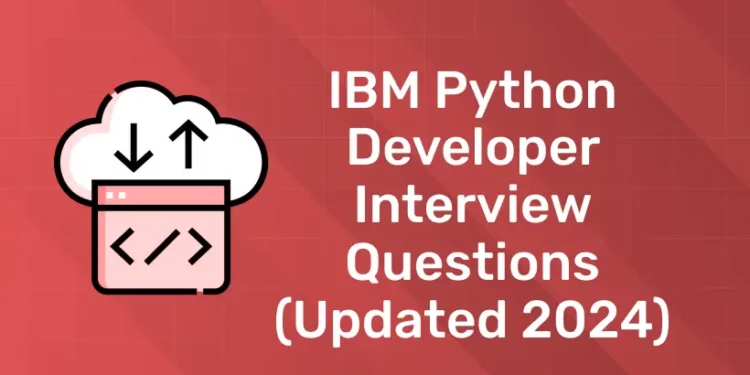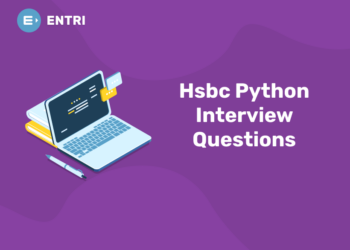Table of Contents
Being a Python developer at IBM, a leader in innovation and technology worldwide, means being well-prepared and possessing a solid grasp of Python’s nuances. Being ready for an IBM Python developer interview will increase your confidence and chances of success, regardless of your degree of experience.
This updated 2024 guide contains the most frequent and difficult interview questions that IBM Python developers may encounter. This extensive book provides you with the knowledge and understanding you need to ace your interview by covering everything from basic ideas to sophisticated problem-solving strategies.
Experience the power of our python programming course with a free demo – enroll now!
Introduction
Located in Armonk, New York, IBM is a multinational technology firm based in the United States that operates in over 171 countries. Established in 1911 in Endicott, New York, the Computing-Tabulating-Recording Company (CTR) was formed by trust merchant Charles Ranlett Flint. “International Business Machines” was the new name the company adopted in 1924.
Worldwide manufacturer and distributor of computer hardware, software, and middleware, IBM is a multinational corporation. For a variety of applications, such as mainframe computers and nanotechnology, it also provides hosting and consulting services. Moreover, IBM is a large research organisation that had held the record for the most yearly U.S. patents produced by a firm for the preceding 28 years as of 2020.
Why Choose IBM?
Known as “Big Blue,” IBM employed more than 345,000 people globally as of 2020, which places it among the 30 corporations that comprise the Dow Jones Industrial Average. A fundamental aspect of IBM’s culture and one that is critical to the company’s longevity is its tolerance for innovation.
1. Innovative Environment
With innovations in artificial intelligence, blockchain, cloud computing, and quantum computing, IBM is at the forefront of technological innovation and always pushing the boundaries. Also among the many chances that await Python developers is working on cutting-edge projects that shape the course of technology.
2. Global Impact
In this sense, IBM provides services and solutions to a wide range of industries and has operations in more than 170 countries. Here working with IBM means being a part of a global team that addresses urgent problems and offers meaningful solutions all across the world. And your efforts will be widely viewed and influential.
3. Career Development
Career development would be like, IBM is committed to the continuous professional development of its employees. And the organisation offers a variety of training programmes, certifications, and tools to help you advance your skills and career. Alos whether you wish to focus in a certain area or explore new technologies, IBM supports you throughout your career.
4. Collaborative Culture
The firm IBM encourages collaboration and a friendly work atmosphere that fosters innovation, creativity, and teamwork. Also you’ll get the ability to collaborate on projects that genuinely effect change and share ideas with some of the most intelligent people in the industry.
5. Commitment to Diversity
This will ensure that, IBM is dedicated to building a diverse and inclusive workforce. The company values different perspectives and experiences in order to create an atmosphere where everyone may thrive and contribute. And IBM demonstrates its commitment to diversity and inclusion through its policies, activities, and projects.
Career Options for Python in IBM
For Python developers, IBM provides a wide choice of job options that meet different interests and skill levels. And IBM offers a position that might fit your professional goals, regardless of your passions—software development, data science, or cybersecurity. The following are some well-known job paths available to Python specialists at IBM:
1. Software Developer/ Engineer
- Role of software developer is utilising Python and related technologies, develop and maintain software applications.
- Skills set includes working understanding of frameworks such as Flask and Django, proficiency with Python, and familiarity with software development procedures.
- And the duties of software developer are working with cross-functional teams to produce high-quality software solutions. And designing, coding, testing, and debugging software applications.
2. Data Scientist/ Analyst
- Role of data scientist is to use Python and programmes like NumPy, Pandas, and scikit-learn to analyse large, complicated data sets.
- Their skill sets incude proficiency in statistical analysis, machine learning, data manipulation, and strong Python programming abilities.
- Duties are creating prediction models, doing data mining, and extracting useful information from massive databases to assist in making business decisions are among the responsibilities.
3. Machine Learning Engineer
- Role of machine learning engineer is to use Python to create and implement machine learning models and algorithms.
- Skillsets include proficiency in Python programming and familiarity with machine learning frameworks such as TensorFlow, PyTorch, and scikit-learn.
- And the duties pf machine learning engineer include creating and implementing machine learning models, performance-enhancing algorithms. and collaborating closely with software engineers and data scientists.
4. DevOps Engineer
- Role of DevOps engineer is to use Python scripting to automate and streamline procedures.
- Skills sets include CI/CD pipelines, Docker, Jenkins, and other DevOps tools are known, as is scripting in Python.
- And their duties are implementing infrastructure as code, overseeing pipelines for continuous integration and delivery. and making sure deployment procedures run smoothly and effectively are among the responsibilities.
5. Cloud Engineer
- The role of cloud engineer is to use Python for automation to manage and launch apps on cloud platforms.
- Skills sets of cloud engineer is Infrastructure administration, programming in Python, and familiarity with cloud computing platforms such as AWS, Azure, or GCP.
- Their duties are managing cloud infrastructure, automating cloud processes, and maximising cloud resources for effectiveness and economy are among the responsibilities.
6. Cybersecurity Analyst
- The cybersecurity analyst role is to use Python for security automation to improve system security.
- Skills set includes knowledge of cybersecurity, scripting in Python, and comfort using security frameworks and tools.
- And their duties are identifying and addressing security risks, conducting vulnerability assessments, and creating automated security solutions are among the responsibilities.
7. AI/ ML Research Scientist
- The role of AI/MI research scientist is to use Python to carry out cutting-edge machine learning and artificial intelligence research.
- Their skill sets are proficiency in Python, solid theoretical and practical understanding of AI/ML, and familiarity with research methodology are among the skills required.
- Also duties include investigating novel AI/ML methodologies, disseminating scholarly articles, and participating in the creation of inventive AI solutions.
Experience the power of our python programming course with a free demo – enroll now!
IBM interview Process
1. Interview Process
- Assessment of Cognitive Ability
- Round of Coding
- Technical Talk
- HR Consultation
2. Interview Rounds
Cognitive Ability Assessment:
- The purpose of this round is usually to assess the candidate’s cognitive abilities. Shortcuts (where the object is to move the blue marble to the stars) and Gridlock (where the object is to place the provided blocks in the designated main area).
- Funny games that are usually included in this round include Resemble (where the goal is to create a required image from a given image after rotation). Numbubbles (where the goal is to pop the bubbles whose sum equals the given target). and Tally Up (where the goal is to determine whether the left-hand side calculation is equal to, greater than, or less than the right-hand side calculation).
- You might need to participate in a WebEx conference during this phase, when a proctor will be observing the candidates while they play the games. Candidates who pass this phase receive connections to the subsequent rounds, and the results are typically processed within 30 minutes.
Coding Round:
- The IBM recruitment process is dynamic, with a coding round. There can be one to four coding questions in it. The amount of time allocated for answering them varies according on how many questions need to be answered.
- A typical question period is between thirty and forty-five minutes for one to two questions, and between one and two hours for three to four questions. This round is all about examining the candidate’s coding abilities and understanding of different data structures and algorithms.
- Any of the contemporary programming languages, which typically include C, C++, Java, and Python, can be used to write code. For these kinds of coding tasks, you should be well-versed in data structures and algorithms and have a considerable amount of experience.
Technical Interviews:
- Those who pass the online exam will receive an invitation to a face-to-face technical interview. Technical interviews are meant to assess your technical skills, which are typically specific to the job for which you are applying, as well as your problem-solving and stress-reduction abilities. Your aptitude for solving problems will also be evaluated by the interviewer.
- In addition to questions regarding your prior projects and work experiences, you’ll be asked about your actions, your use of technology, and the degree of success you achieved. Learn the foundations of computer science to get ready.
- The applicant must be fluent in at least one of the current programming languages, such as Python, Java, C, or C++. Basic computing principles questions should also be on your radar.
- The majority of the questions will likely come from Computer Networks (CN), Operating Systems (OS), DataBase Management Systems (DBMS), Object-Oriented Programming Systems (OOPs), and Computer Organisation and Architecture (CoA).
- The amount of technical interviews you have will depend on a variety of factors, including how well you performed in previous rounds, your job profile, experience, and the firm’s requirements. Each candidate will typically face two rounds of technical interviews.
HR Interview:
- Those who pass the technical interview will move on to the HR phase. Assessing an applicant’s personality, background, strengths, and weaknesses is the primary goal of an HR interview; this helps determine whether or not the individual is a good fit for the role. It is therefore essential to prepare thoroughly for the HR interview.
- Examine your CV to ensure that all relevant personal information has been included and that the material is correct to the best of your knowledge.
- They may also cast doubt on IBM’s objectives, tenets, and organisational structure, as well as the year of the company’s founding. Be ready to answer any questions regarding your resume that may come up. Explain why you are interested in the field and what drives you most in your explanations.
IBM Interview Questions for Freshers in Python
Q. Define Python?
Q. What is a dynamically typed language?
- Static: Before execution, data types are verified.
- Dynamic: During execution, data types are verified.
Q. What is PIP?
Answer: The Python Installer Package, or PIP for short, offers a smooth interface for installing different Python modules. It’s a command-line utility that can look up packages online and install them without requiring user input.
Q. What is a zip function?
Answer: The Python zip() function yields a zip object that maps many containers’ comparable indexes. It starts with an iterable, turns it into an iterator, and then aggregates the elements according to the passed iterables. An iterator of tuples is returned.
Q. Does Python supports multiple Inheritance?
Answer: Unlike Java, Python allows for multiple inheritance. A class may inherit from more than one parent class thanks to multiple inheritances.
Q. What is Polymorphism in Python?
Answer: Being polymorphic refers to having numerous forms. It is therefore possible for the child class to have a method with the same name, ABC, but with different parameters and variables if the parent class has a method with the same name. Python is polymorphism-friendly.
Q. What is Walrus Operator?
Answer: You can give a variable in an expression a value by using the Walrus Operator. When you need to utilise a value repeatedly in a loop but don’t want to repeat the calculation, this can be helpful.
The `:=} syntax represents the Walrus Operator, which can be applied in a range of situations, including as while loops and if statements.
Q. What is the purpose of the Python “#” symbol?
Answer: Commenting on anything that appears on the line after “#” is done is done.
Q. What distinguishes an immutable data type from a mutable data type?
Answer:
- Data types that are mutable are ones that can be altered, or changed at runtime. Such as a dictionary, list, etc.
- Immutable data types are unchangeable at runtime, meaning they cannot be modified. For example, tuple, string, etc.
Q. What distinguishes a dictionary from a set?
Answer: The set is an unordered, changeable, iterable collection of data types without duplicates.
In Python, a dictionary is an ordered set of data values that is similar to a map in terms of storage.
Q. How do a Dictionary and a Set differ from one other?
Answer: The set is a changeable, iterable, unordered collection of data types without duplicate entries.
Python dictionaries, which are used to store data values like maps, are ordered collections of data values.
Q. In Python, what are generators?
Answer: The generator is a method that describes how to implement iterators in Python. With the exception of yielding expression in the function, it is a typical function. The next() function and __itr__ are not implemented, and additional overheads are also decreased.
Experience the power of our python programming course with a free demo – enroll now!
Q. Create a Python programme that illustrates how queues and stacks work?
Answer:
# Programme to demonstrate stack implementation
stack = []x = list(range(0,5,2))for i in range(1,4):if i < len(a):stack.append(a[i])else:stack.pop()print(stack) |
#Programme to show how to implement queue-first FIFO
#Implementation of Queue - FIFOqueue = []x = list(range(0,5,2))for i in range(1,4):if i < len(a):queue.append(a[i])else:queue.pop(0)print(queue) |
Q. Create a Python programme that can reverse a string without requiring the reverse() or slicing operations?
Answer:
# Defining the functiondef reverseString(a):# Declaring an empty StringNewString = ""# Traversing through individual characters in a stringfor i in a:# Add the character to the empty stringNewString = i + NewString# return the new stringreturn NewString# Sample Stringstring = "Entri App"# Function CallReversedString = reverseString(string)# Printing Outputprint(ReversedString) |
Output: ppA irtnE
Q. Write a Python application that eliminates redundant entries from a list.
Answer: It is fairly simple to remove duplicates from a list by first turning it into a set and then back again. Since it is a set attribute, it can only contain unique values.
# Sample Data in ListSample = [1,1,0,0,1,0,2,0,3,2,2,4,4,2,3]# Converting the list to set to remove duplicatesSetSample = set(Sample)# Converting the set to a list againListSample = list(SetSample)# Printing the Outputprint(ListSample) |
Q. How does method overriding work? Could you please provide a Python example?
Answer: A method that overrides the method of its parent class during inheritance is known as method overriding, and it is a polymorphism notion. Let’s examine a basic illustration:
class Animal:def species(self, a):self.a = aprint("species of the animal is : {}".format(self.a))class Snakes(Animal):def species(self):print("Species is Reptiles")#calling the parent class methodobj = Animals()obj.species("Amphibian")#calling the class object overrides the parent class methodobj1 = pandas()obj1.species() |
Q. What is Scope in Python?
- The local objects accessible in the current function are referred to as the local scope.
- The items that have been accessible since the beginning of code execution are referred to as the global scope.
- The global objects of the current module that are accessible within the programme are referred to as a module-level scope.
- The term “outermost scope” describes all of the program’s callable built-in names. The name mentioned is found by searching the items in this scope last.
Q. What are the common built-in data types in Python?
1. None Type:
| Class Name | Description |
|---|---|
| NoneType | Represents the NULL values in Python. |
2. Numeric Types:
| Class Name | Description |
|---|---|
| int | keeps binary, hexadecimal, and octal integer literals stored in an integer format. |
| float | stores literals as floating-point numbers that contain exponent signs and/or decimal values. |
| complex | Stores complex numbers in the format (A + Bj) and has the following properties: real andimag |
| bool | Keep boolean value (True or False). |
3. Sequence Types:
| Class Name | Description |
|---|---|
| list | A sequence that can be changed to store a group of objects. |
| tuple | Unchangeable order utilised to keep track of a group of objects. |
| range | Represents an unchangeable numerical sequence that was created during execution. |
| str | Textual data is stored in an immutable Unicode code point sequence. |
Note: Additional kinds for processing are also included in the standard library:
1. Binary data, like memoryview’s bytearray bytes,
2. Text strings, like str.
4. Mapping Types:
In Python, a mapping object can map hashable values to arbitrary objects. There is presently only one common mapping type—the dictionary—and mapping objects are modifiable.
| Class Name | Description |
|---|---|
| dict | Keeps comma-separated list of key: value pairs |
5. Set Types:
| Class Name | Description |
|---|---|
| set | An unordered, mutable collection of unique hashable objects. |
| frozenset | Collection of unique hashable objects that is immutable. |
6. Modules:
An additional built-in type that the Python Interpreter supports is called Module. It allows attribute access: mymod.myobj, where mymod is a module and myobj refers to a name defined in m’s symbol table. This is the only unique operation it enables. Although it is not advised nor feasible to directly assign to this module, the symbol table for the module is located in a very specific attribute of the module __dict__.
7. Callable Types:
The kinds to which function calls can be applied are known as callable types. These could be built-in functions, methods, and classes, as well as user-defined functions, instance methods, and generator functions. See the docs.python.org manual for a comprehensive overview of the callable kinds.
Experience the power of our python programming course with a free demo – enroll now!











